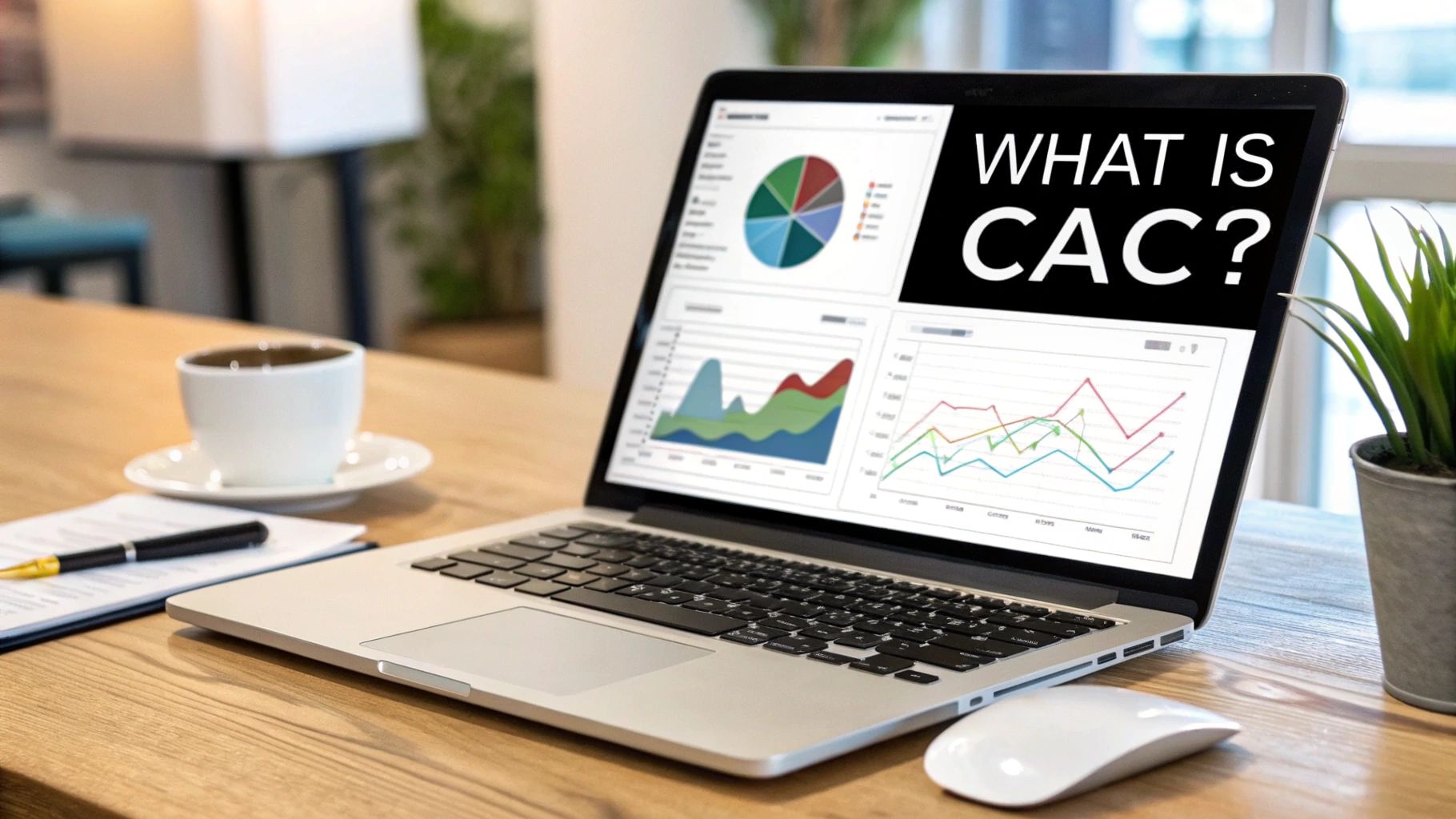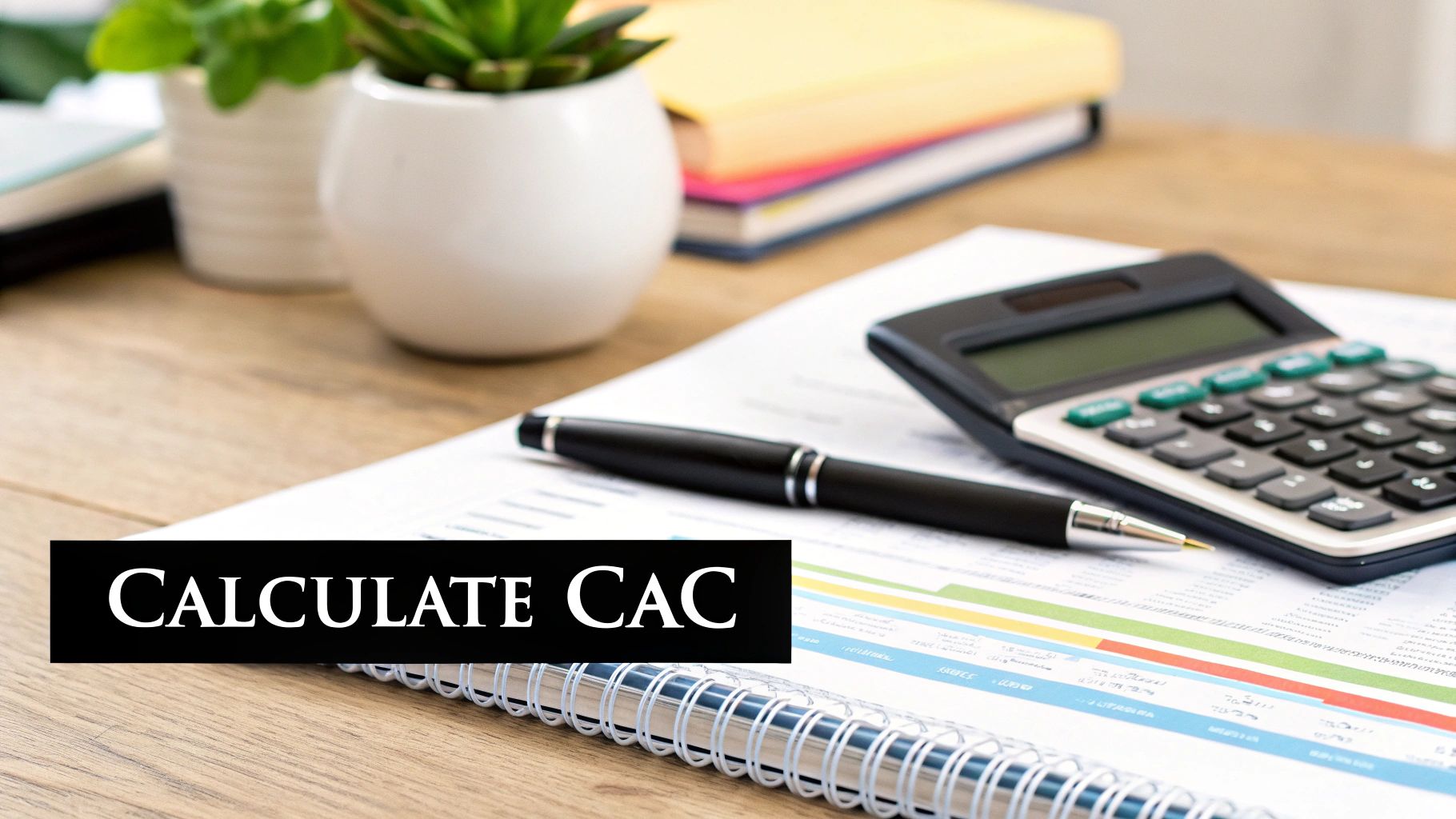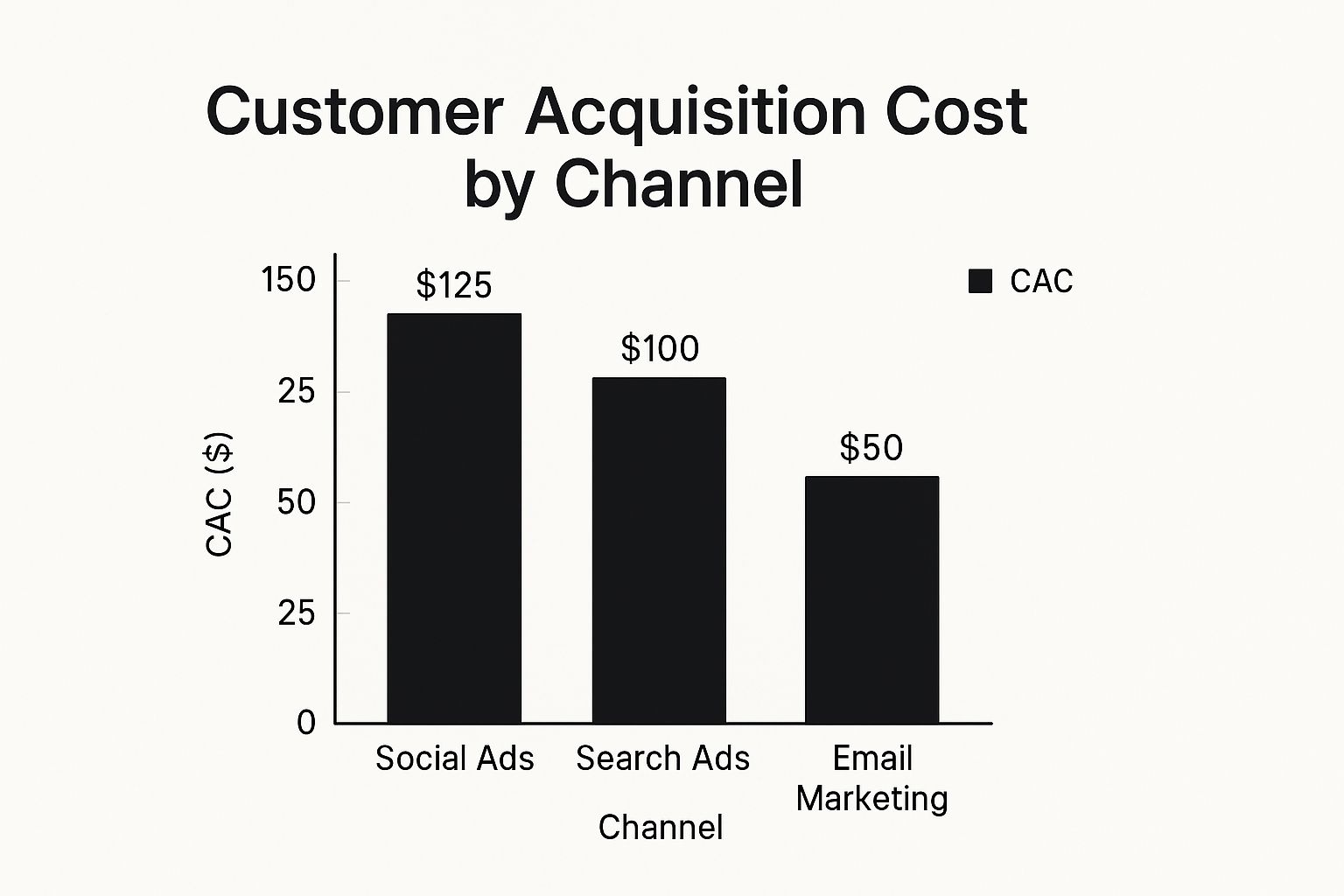Customer Acquisition Cost Calculator | Boost Your ROI
Customer Acquisition Cost Calculator | Boost Your ROI
Mastering The Fundamentals Of Customer Acquisition Cost

Understanding Customer Acquisition Cost (CAC) is crucial for any business. This metric shows how much you spend to get each new customer. It offers valuable insights into your marketing ROI and profitability. Successful businesses prioritize their CAC because it directly impacts their bottom line. Tracking and optimizing your CAC is essential for sustained growth.
Why CAC Matters
Tracking acquisition costs sets apart thriving companies from struggling ones. A business might have impressive revenue, but a high CAC can compromise profitability. This is why a deep understanding of CAC is so important. Before diving in, it's helpful to understand the formula. You can find a detailed explanation of the Customer Acquisition Cost formula.
The CAC Calculation
Calculating CAC is straightforward: CAC = (Total Marketing & Sales Costs) / (Number of New Customers Acquired). However, determining which costs to include requires careful thought.
Marketing and sales costs cover various expenses. These include advertising, salaries, software subscriptions like HubSpot, content creation, and more. Accurate cost attribution is crucial for a precise CAC calculation. For more in-depth information, check out this article on how to master calculating CAC.
Benchmarking Your CAC
After calculating your CAC, compare it to industry standards. This helps you understand your performance compared to competitors and identify areas for improvement. Using CAC calculators has become increasingly important, especially for mobile apps.
In 2020, the average cost to acquire a mobile app user ranged from $1 to $5. This varied based on factors like app type and target market. Understanding and managing CAC is crucial for businesses of all sizes. You can learn more about mobile app user acquisition costs.
CAC And Sustainable Growth
The connection between acquisition cost and sustainable growth is complex. Getting new customers is essential for growth, but the acquisition cost shouldn't exceed the customer's lifetime value. Finding the right balance is key.
Businesses must minimize CAC and maximize customer value. This involves improving customer retention, increasing average order value, and building customer loyalty. Mastering these fundamentals allows businesses to use their CAC calculator as a powerful tool for sustainable, profitable growth.
Building Your Custom CAC Calculator That Actually Works
Stop guessing about your acquisition costs. A custom customer acquisition cost (CAC) calculator is crucial for understanding your business's profitability. This isn't just about plugging numbers into a generic formula. It requires a deep dive into the specifics of your business. Before we begin, it's helpful to have a solid understanding of the basic CAC calculations. You can find a great guide here: How to Calculate Customer Acquisition Cost.
Identifying Your True Costs
Building a custom CAC calculator starts with pinpointing the costs that truly matter. Marketing and sales expenses are the obvious ones. This includes ad spend, salaries for your sales and marketing teams, software subscriptions like HubSpot, content creation costs, and sales incentives or commissions.
However, other costs might contribute to acquiring customers, depending on your business. For example, customer onboarding costs can be a significant factor, especially for SaaS businesses or those with complex services. The key is to be thorough and include all expenses directly related to turning a lead into a paying customer.
Tailoring Your Calculator to Your Business Model
Different business models need different approaches to calculating CAC. A SaaS business, with its recurring revenue, will have a different approach than an e-commerce business focused on one-time purchases. B2B businesses with longer sales cycles also have different factors than B2C businesses.
- SaaS: Focus on subscriber acquisition costs and consider churn rate.
- E-commerce: Include costs like shipping and fulfillment, along with marketing and sales.
- B2B: Account for longer sales cycles and the higher sales costs of closing larger deals.
- Service Businesses: Factor in the cost of service delivery as part of the acquisition cost.
For example, a SaaS business might use a CAC calculator that includes the cost of free trials. An e-commerce business might focus on the cost per order, including expenses like returns and customer support.
To help you understand the key components, let's look at the table below:
To help illustrate the different components needed for a CAC calculator across different business models, the following table provides a breakdown:
Components of a Comprehensive CAC Calculator This table outlines all the essential components that should be included in a well-designed CAC calculator across different business types.
| Expense Category | Description | Calculation Method | B2B vs B2C Differences |
|---|---|---|---|
| Marketing Expenses | Costs associated with marketing campaigns | Total Marketing Spend / Number of Customers Acquired | B2B often involves higher costs per lead due to longer sales cycles and targeted advertising. |
| Sales Expenses | Costs related to the sales team and processes | Total Sales Costs / Number of Customers Acquired | B2B sales teams often have higher salaries and commission structures. |
| Onboarding Costs | Expenses for onboarding new customers | Total Onboarding Costs / Number of Customers Acquired | B2B onboarding can be more complex and involve dedicated account management. |
| Customer Support | Costs associated with supporting existing customers | Total Customer Support Costs / Number of Customers Acquired | B2B often requires more specialized support and account management. |
This table highlights the common expenses to consider when building a CAC calculator. Remember to tailor the specific categories and calculations to your unique business needs.
Avoiding Common Calculation Mistakes
Several common mistakes can lead to inaccurate CAC calculations. One is overlooking relevant costs. This can create an artificially low CAC, giving a false sense of profitability. Another mistake is incorrectly attributing costs. For instance, assigning all marketing costs to new customer acquisition, even though some might be for customer retention.
Finally, ignoring the time dimension can skew results. A business with a long sales cycle might seem to have a high CAC initially, but this could balance out with higher customer lifetime value over time. Building a solid, accurate CAC calculator requires careful attention and a deep understanding of your business. It should offer actionable insights, not just surface-level metrics.
Channel Optimization: Where Your CAC Calculator Proves Its Worth

Your customer acquisition cost (CAC) calculator isn't just about calculating overall CAC. It's a powerful tool for optimizing your marketing budget across different channels. Smart marketers use channel-specific CAC analysis to pinpoint which channels are driving profitable customer acquisition.
This allows them to cut underperforming channels and invest more in high-ROI channels. For example, you might discover that social media campaigns have a much lower CAC than paid search, which can inform future budget decisions. Learn more about optimizing channel performance: How to master marketing channel performance.
Setting Up Proper Attribution Models
Accurate attribution models are crucial for channel optimization. These models determine how credit for a conversion is assigned to different touchpoints in the customer journey. This is essential because surface-level metrics, like last-click attribution, can be deceptive.
A customer might first discover your product through a social media ad but convert after clicking a search ad. A proper attribution model would acknowledge both channels, revealing the true impact of each. Understanding the customer journey also enables better targeting and personalized messaging at each stage.
Cohort Analysis: Uncovering Hidden Insights
Cohort analysis provides deeper insights into channel performance, going beyond simple attribution. A cohort is a group of customers acquired through the same channel during a specific time frame. By analyzing the behavior and lifetime value of different cohorts, you can identify which customer segments provide the highest return.
This information allows you to refine your channel strategy, focusing on channels that attract the right customers, not just any customers. Acquiring customers has always been a challenge, especially in competitive markets.
Using technology like Google Ads and Facebook Ads has become vital. As of 2023, the average cost per click (CPC) for Google Ads ranged from $0.70 to $7.00, depending on the industry, directly impacting CAC. CAC calculators help optimize ad spend and achieve better ROI. Explore CAC further: here.
Data-Driven Decisions Over Marketing Conventions
Many businesses blindly follow marketing conventions or trends. However, successful companies use data to guide their acquisition strategy. By using their CAC calculator and performing channel-specific analysis, they gain valuable insights.
These insights allow them to allocate their budget efficiently and maximize ROI. This data-driven approach enables agile adjustments to marketing strategies and keeps businesses ahead of the competition. By understanding which channels deliver the most valuable customers, companies can optimize their efforts for long-term, sustainable growth.
The CAC to CLV Ratio: Your Business's Vital Sign
The CAC:CLV ratio, comparing Customer Acquisition Cost (CAC) to Customer Lifetime Value (CLV), is essential for sustainable growth. It provides a deeper understanding of your business's health than either metric alone, and analyzing successful businesses shows just how critical this ratio is.
Calculating Customer Lifetime Value (CLV)
Calculating CLV adapts to your business model. For subscription services, it's based on predicted subscription length and recurring payments. For product-based businesses or e-commerce, it involves estimating a customer's total purchase value over their relationship with your brand. Even simplified CLV calculations offer valuable insights.
Warning Signs and Strategies for Improvement
A consistent CAC exceeding your CLV is a major warning sign. This indicates that acquisition costs outweigh customer value, an unsustainable model. For instance, a $100 CAC for a customer generating only $50 in lifetime revenue means a loss with every new customer.
Understanding Customer Acquisition Costs
The infographic below shows average customer acquisition costs across various marketing channels, helping identify potential areas for optimizing your strategy.

As shown, social ads generally have a lower CAC than search ads and email marketing, suggesting they might be more efficient for customer acquisition. However, deeper channel-specific analysis, like that offered by LeadPulse, is vital for informed decisions.
Improving Your CAC:CLV Ratio
Two key ways to improve the CAC:CLV ratio are:
- Reduce Acquisition Costs: Optimize marketing spend, target the right audience, and improve conversion rates. LeadPulse helps businesses understand lead sources, enabling efficient resource allocation and lower CAC.
- Increase Customer Lifetime Value: Implement effective retention strategies, like loyalty programs, personalized communication, and proactive customer support. Upselling and cross-selling can also significantly boost CLV.
Benchmarking and Industry Standards
Effective use of customer acquisition cost calculators is essential for efficient customer base expansion. E-commerce giants like Amazon and Alibaba utilize data analytics and marketing automation to minimize CAC and optimize marketing channels. As of 2022, the average CAC for e-commerce companies was $10 to $20 per customer, highlighting the importance of precise marketing for profitability. CAC calculators help businesses benchmark against industry standards and make informed decisions regarding marketing investments. Learn more about CAC: What is CAC.
To help you better understand where your business stands, let's look at some industry benchmarks:
CAC:CLV Ratio Benchmarks by Industry
| Industry | Average CAC | Average CLV | Ideal CAC:CLV Ratio | What It Means For Your Business |
|---|---|---|---|---|
| SaaS | $50-$200 | $200-$1000 | 1:3 - 1:5 | High CLV is crucial; focus on retention and upselling. |
| E-commerce | $10-$20 | $50-$200 | 1:3 - 1:4 | Balance acquisition with repeat purchases and customer loyalty. |
| Mobile Gaming | $1-$5 | $10-$50 | 1:5 - 1:10 | High volume, low CLV; focus on in-app purchases and engagement. |
This table offers a general overview, and your specific ideal ratio might vary. However, consistently monitoring and striving to improve your CAC:CLV ratio is key to long-term success. By effectively using both reduction and growth strategies, businesses can achieve a healthy CAC:CLV ratio and drive sustainable growth.
Taking Your CAC Calculator to the Next Level With Automation

Manually tracking your Customer Acquisition Cost (CAC) is time-consuming and prone to errors. For accurate insights and a competitive edge, forward-thinking businesses are automating their CAC calculations. This automation allows for faster decision-making and better data analysis.
Integrating Your CAC Calculator With Existing Systems
Integrating your CAC calculator with your existing CRM and marketing automation platforms is key. This integration creates a streamlined data flow, eliminating manual data entry and reducing human error.
For example, connecting your CRM like HubSpot to your advertising platforms lets you automatically track ad spend and attribute conversions. This data feeds directly into your CAC calculator.
This connection allows you to create live dashboards that provide real-time visibility into your CAC. These dashboards can flag potential issues, like rising acquisition costs or underperforming campaigns, before they significantly impact your bottom line. This proactive approach is essential for maintaining a healthy CAC and maximizing ROI.
Automation Approaches for Different Business Sizes
Different automation strategies suit businesses of varying sizes. Smaller businesses might begin with simple spreadsheet formulas for basic CAC calculations. As they grow, they can adopt more sophisticated tools.
- Spreadsheets: Basic formulas can automate the core CAC calculation.
- Marketing Analytics Platforms: Tools like LeadPulse offer advanced tracking and attribution capabilities. These go beyond basic UTM parameters to identify the true source of your leads and customers. This allows businesses to better understand the customer journey and optimize their spending.
- Custom Integrations: Connecting your CRM, advertising platforms, and other marketing tools through APIs creates seamless data flow and automated reporting.
- Machine Learning Models: Larger enterprises can use machine learning to predict future CAC based on historical data and market trends.
Benefits of Automated CAC Tracking
Automating your CAC calculator offers significant advantages. The most obvious benefit is reduced human error. Manual data entry is prone to mistakes, leading to inaccurate CAC calculations and poor decision-making. Automation removes this risk, ensuring data accuracy and reliability.
Automated tracking also provides faster insights. Real-time data updates allow you to quickly identify trends and react to market changes. This agility is essential in today’s business environment. Finally, automation frees up your team to focus on strategic work, rather than manual data entry.
This allows them to spend more time optimizing campaigns, improving customer experience, and ultimately, driving business growth. Understanding how automation enhances a CAC calculator helps businesses leverage this essential tool for sustainable profitability.
Actionable Strategies to Slash Your Customer Acquisition Costs
Knowing your customer acquisition cost (CAC) is just the first step. Now it's time to put that knowledge to work and develop strategies to bring those costs down. This means taking a close look at your entire marketing and sales process. Let's explore some proven tactics that can make a real difference.
Optimizing Ad Targeting Parameters
One of the best ways to lower your CAC is to refine your ad targeting. When your ads reach the right people, you avoid wasting money on leads that aren't a good fit. This requires a solid understanding of your ideal customer. Think demographics, interests, and online behavior. Platforms like Facebook Ads and Google Ads offer powerful targeting options to help you hone in on your perfect audience.
For example, instead of using general keywords, try using long-tail keywords. These are longer, more specific phrases that better reflect what a customer is actually searching for. This precision targeting connects you with a more qualified audience and boosts your conversion rates, ultimately driving down your CAC.
Improving Landing Page Conversions
Your landing page is critical. A poorly designed landing page can seriously hurt your conversion rates and push your CAC up. Focus on creating clear and concise messaging that showcases the value of your product. Use strong calls to action and eliminate anything that might distract a potential customer.
A/B testing is a powerful tool. Experiment with different headlines, images, and forms on your landing page to see what performs best with your target audience. This iterative approach allows you to steadily improve your conversion rates and lower your customer acquisition costs.
Enhancing Sales Team Efficiency
Your sales team is a key player in customer acquisition. Making them more efficient has a direct impact on your CAC. A CRM system can streamline their workflow and automate tasks like lead nurturing and follow-up. Investing in sales training can also improve closing rates.
By optimizing your sales process and giving your sales team the tools they need to succeed, you reduce the time and resources required to acquire each new customer. This can translate to significant savings. You might be interested in: How to master marketing ROI measurement.
Implementing Customer Referral Programs
Word-of-mouth marketing is incredibly valuable. A customer referral program encourages your current customers to bring in new business. Referred customers often have a higher lifetime value, making this a cost-effective acquisition strategy.
Offering incentives, like discounts or rewards for both the referrer and the new customer, can supercharge your referral program's success.
Ready to take control of your customer acquisition costs and boost your marketing ROI? LeadPulse provides the tools and insights you need to understand where your leads and customers are coming from, allowing you to optimize your marketing spend and increase profitability. Visit LeadPulse today and discover the power of precise lead tracking.